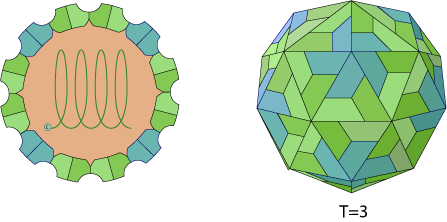VIRION

Non-enveloped, spherical, about 25 nm in diameter, pseudo T=3 icosahedral capsid surrounding the naked RNA genome. The capsid consists of a densely-packed icosahedral arrangement of 60 protomers, each consisting of 3 polypeptides.
GENOME
Monopartite, linear ssRNA(+) genome of 9 kb, polyadenylated, lacking a cap structure, has three open reading frames. ORF-1 codes for the replicases polyprotein, ORF-2 codes for the 3 structural proteins polyprotein abd ORF-3 overlaps ORF-2. The three ORFs are flanked by a 5'-UTR and a 3'-UTR. Sub-genomic RNAs are probably synthesized to translate ORF-2 and ORF-3.
GENE EXPRESSION
The virion RNA is infectious and serves as both the genome and viral messenger RNA.
ENZYMES
- RNA-dependent RNA polymerase [RdRp Q33DY4]
- VPG-type capping [VPg Q33DY4]
- NTPase-helicase [NTPase Q33DY4]
- Polyprotein major protease (Peptidase C3) [Protease Q33DY4]
REPLICATION
CYTOPLASMIC
- Attachement of the virus to host receptors mediates virus internalization.
- The viral RNA is translated into a processed polyprotein.
- Replication occurs in viral factories made of membrane vesicles derived from the ER. A dsRNA genome is synthesized from the genomic ssRNA(+).
- The dsRNA genome is transcribed/replicated thereby providing viral mRNAs/new ssRNA(+) genomes.
- New genomic RNA is believed to be packaged into preassembled procapsids.
- Virions accumulate in the host cytoplasm forming a crystalline array.
- Cell lysis and virus release.

